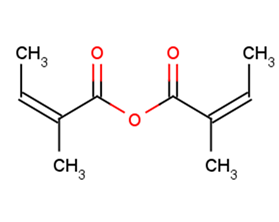
Angelic anhydride
CAS No. 94487-74-8
Angelic anhydride( —— )
Catalog No. M19279 CAS No. 94487-74-8
Angelic Anhydride is a reagent in the improved synthesis of angelate esters, which are the active chemical behind the strong pain-relieving and spasmolytic action of extracts from the plant butterbur.
Purity : >98% (HPLC)
 COA
COA
 Datasheet
Datasheet
 HNMR
HNMR
 HPLC
HPLC
 MSDS
MSDS
 Handing Instructions
Handing Instructions
| Size | Price / USD | Stock | Quantity |
| 25MG | 83 | In Stock |


|
| 50MG | 118 | In Stock |


|
| 100MG | Get Quote | In Stock |


|
| 200MG | Get Quote | In Stock |


|
| 500MG | Get Quote | In Stock |


|
| 1G | Get Quote | In Stock |


|
Biological Information
-
Product NameAngelic anhydride
-
NoteResearch use only, not for human use.
-
Brief DescriptionAngelic Anhydride is a reagent in the improved synthesis of angelate esters, which are the active chemical behind the strong pain-relieving and spasmolytic action of extracts from the plant butterbur.
-
DescriptionAngelic Anhydride is a reagent in the improved synthesis of angelate esters, which are the active chemical behind the strong pain-relieving and spasmolytic action of extracts from the plant butterbur.
-
In Vitro——
-
In Vivo——
-
Synonyms——
-
PathwayOthers
-
TargetOther Targets
-
RecptorOthers
-
Research Area——
-
Indication——
Chemical Information
-
CAS Number94487-74-8
-
Formula Weight182.21
-
Molecular FormulaC10H14O3
-
Purity>98% (HPLC)
-
Solubility——
-
SMILESCC=C(C)C(=O)OC(=O)C(=CC)C
-
Chemical Name——
Shipping & Storage Information
-
Storage(-20℃)
-
ShippingWith Ice Pack
-
Stability≥ 2 years
Reference
molnova catalog



related products
-
Obexelimab
Obexelimab (XmAb5871) is a humanized, Fc-engineered anti-CD19 antibody with enhanced affinity for FcγRIIb, utilized in the study of autoimmune diseases .
-
GRL-0496
GRL-0496 is a potent inhibitor with an enzyme inhibitory activity against SARS-CoV 3CLpro with an IC50 of 30 nM and antiviral potency with an EC50 value of 6.9 μM.
-
FKBP12 PROTAC RC32
FKBP12 PROTAC RC32 is a PROTAC-like degrader targeting FKBP12. It can degrade FKBP12 in organs after intraperitoneal administration.



 Cart
Cart
 sales@molnova.com
sales@molnova.com


